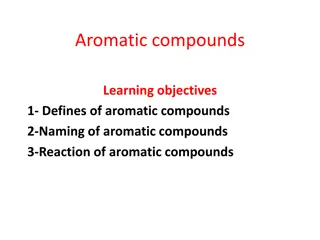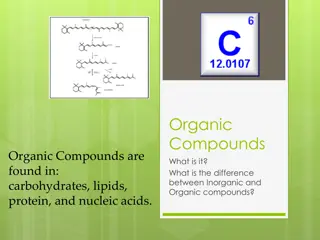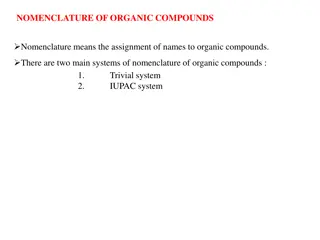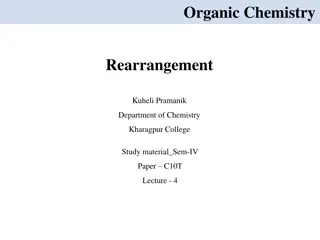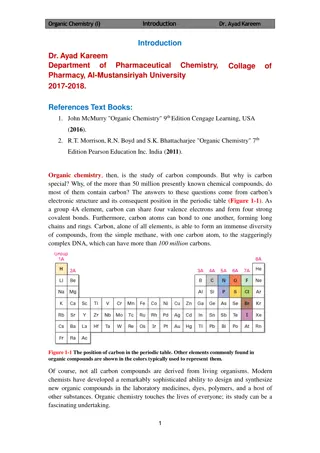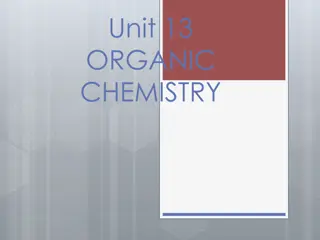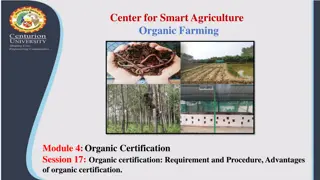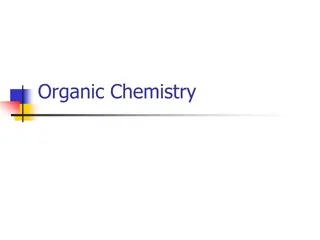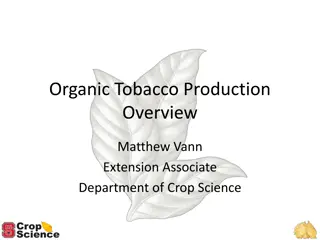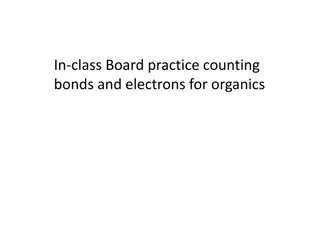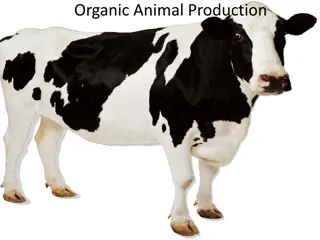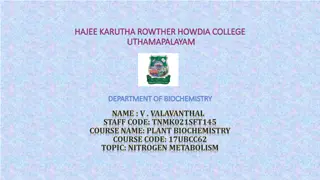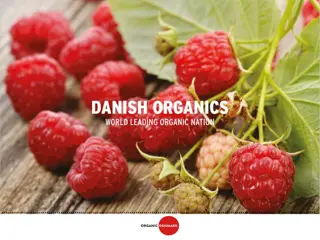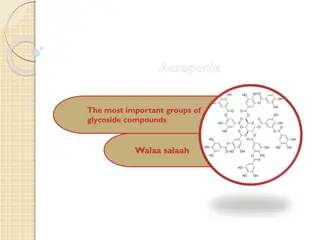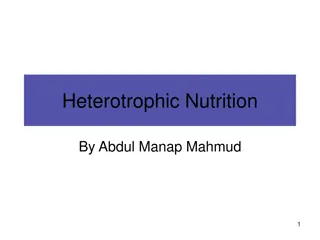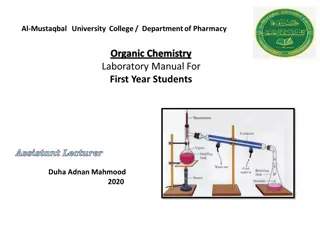Organometallic Chemistry (CHEM 42 1)
Organometallic chemistry delves into compounds with carbon-metal bonds, merging concepts from inorganic and organic chemistry. The field encompasses diverse compounds like ferrocene and tris(triphenylphosphine)rhodium carbonyl hydride, with nomenclature based on naming organic groups and adding meta
1 views • 13 slides
Aromatic compounds
Aromatic compounds are chemical compounds containing a ring with delocalized pi electrons. Learn about the definition, naming conventions, and reactions of aromatic compounds such as benzene. Explore topics like aryl groups, halogenation reactions, and the mechanism for bromination of benzene.
0 views • 19 slides
CORE Organic Pleiades Network First Annual Workshop Roadmap 2030 - Event Recap
The CORE Organic Pleiades Network held its first annual workshop in Brussels, focusing on organic research and innovation in the European agri-food sector. The event discussed HEU partnerships, national/regional action plans, research funding, and more. CORE Organic aims to enhance knowledge and inn
0 views • 37 slides
Organometallic Compounds of Group 2 Elements
In the realm of organometallic chemistry, Group 2 elements, specifically alkaline earth metals like beryllium and magnesium, exhibit intriguing properties and reactivities. The chemistry of these elements, mimicking that of Group 12 elements in many aspects, leads to the formation of various organom
5 views • 27 slides
Understanding the Diels-Alder Reaction in Practical Organic Chemistry
The Diels-Alder reaction is a fundamental method in organic chemistry for producing cyclic organic compounds by combining a conjugated diene with an alkene. This reaction, named after Otto Diels and Kurt Alder, involves the formation of a six-membered ring with specific bond rearrangements. Conjugat
4 views • 15 slides
Understanding Organic Compounds and Their Importance in Daily Life
Explore the world of organic compounds, including their definition, difference from inorganic compounds, common elements found in them, and the significance of hydrocarbons. Learn about the essential role of organic compounds in living organisms, such as proteins, carbohydrates, and fats, and how th
1 views • 51 slides
Organic vs Conventional Farming: An Overview
In the debate between organic and conventional farming, both methods have their pros and cons. While organic foods are perceived to follow stricter safety standards, both types meet FDA and USDA regulations. They offer similar nutritional value, but organic farming tends to have lower efficiency due
0 views • 6 slides
Overview of Organic Compounds Nomenclature
Nomenclature of organic compounds involves assigning names based on two main systems - Trivial system and IUPAC system. Trivial system utilizes names related to discoverers or sources, often with Latin or Greek roots. Saturated hydrocarbons, known as paraffins, contain single bonds and are less reac
0 views • 27 slides
Understanding Biosynthetic Pathways in Living Organisms
Biosynthesis, also known as anabolism, involves the formation of complex organic compounds from simple subunits catalyzed by enzymes within living organisms. This process is vital for the development of life and the production of essential compounds like carbohydrates, proteins, vitamins, antibiotic
1 views • 21 slides
Dakin Rearrangement in Organic Chemistry: Mechanism and Positional Effects
The Dakin Rearrangement, also known as Dakin oxidation, is an organic redox reaction involving hydroxylated phenyl aldehydes or ketones reacting with hydrogen peroxide to form benzenediols and carboxylates. The mechanism includes nucleophilic addition, [1,2]-aryl migration, and final product formati
1 views • 9 slides
Mastering Compound Naming for Chemistry Students
Develop your ability to name compounds and write their chemical formulas with ease by understanding the naming conventions for different compound types. Learn about compounds composed of metal and non-metal elements, compounds containing oxygen, and those made only of non-metals. Practice naming spe
2 views • 14 slides
Overview of Anticestodal Drugs in Veterinary Pharmacology
Anticestodal drugs play a crucial role in combating tapeworm infections in veterinary medicine. These drugs are classified into taeniafuges and taenicides, with examples of natural and synthetic compounds highlighted. Natural compounds like pumpkin seeds and male fern are traditionally used for thei
0 views • 29 slides
Separation and Purification of Organic Compounds: Methods and Techniques
The separation and purification of organic compounds are essential processes to obtain pure products, as impurities and side reactions can affect the quality of the compounds. Methods such as solution and filtration, crystallization, distillation, extraction, sublimation, and chromatography are comm
8 views • 15 slides
Understanding Organic Chemistry: Introduction to Carbon Compounds
Organic chemistry is the study of carbon compounds, with carbon's unique electronic structure allowing for a vast array of compounds. This field touches many aspects of life, from medicines to polymers. The nucleus of an atom, comprising protons and neutrons, is surrounded by electrons occupying orb
1 views • 5 slides
Exploring Organic Chemistry Fundamentals
Delve into the world of organic chemistry, understanding the nature of organic compounds, the unique attributes of carbon, and the properties of these compounds. Discover the significance of molecular, structural, and condensed formulas, along with insights into hydrocarbons and the concept of homol
4 views • 56 slides
Solubility Rules from the University of South Carolina
This resource outlines the solubility rules for various compounds based on their chemical properties. It explains the solubility of compounds of alkali metals, ammonium salts, nitrates, chlorides, sulfates, and more. The rules provide insights into which compounds are soluble or insoluble in aqueous
1 views • 10 slides
Understanding Organic Certification and NPOP in India
Organic certification is crucial for ensuring the quality and authenticity of organic products. This involves adhering to strict production standards and undergoing periodic inspections. In India, the National Programme on Organic Production (NPOP) plays a significant role in certifying organic comm
0 views • 10 slides
Nomenclature of Bridge Compounds in Organic Chemistry
Understanding the nomenclature of bridge compounds is essential in organic chemistry. This involves defining bridge heads, bridges, main ring selection, main bridge heads, main bridges, secondary bridges, and more. The IUPAC nomenclature of bridge systems includes indicating the number of rings usin
0 views • 9 slides
Understanding the Role of Starter Culture in Fermented Milk Products
Starter cultures play a crucial role in the production of fermented milk products by producing antimicrobial compounds like organic acids, H2O2, CO2, aroma compounds, fatty acids, and bacteriocins. These compounds help prevent spoilage by inhibiting the growth of harmful bacteria and altering cellul
6 views • 9 slides
Concerns and Recommendations on Non-Organic Agricultural Ingredients
Various Member States express concerns about the inclusion of new non-organic agricultural ingredients in Regulation 889/2008 Annex IX, emphasizing the need to maintain the integrity of organic production. Suggestions include keeping the list as short as possible, searching for organic alternatives,
0 views • 19 slides
Alkaloids and Heterocyclic Compounds: A Comprehensive Overview
Alkaloids are natural compounds containing nitrogen, with various pharmacological activities. Heterocyclic compounds, essential to life, include a diverse range of compounds such as alkaloids, antibiotics, and vitamins. The lecture delves into the properties, classifications, and examples of these c
12 views • 7 slides
Overview of Global Farmed Salmon and Organic Production
The data showcases the production figures for global farmed salmon across various countries, with Norway leading the production, followed by Chile, Scotland, and others. Additionally, insights into the growing organic salmon production, vulnerabilities in the sector, and details on organic mussels p
0 views • 9 slides
Exploring the World of Organic Chemistry
Organic chemistry delves into the study of carbon compounds beyond just living organisms. With carbon's unique bonding capabilities, a vast array of useful compounds are created naturally and synthetically, shaping the foundation of modern chemistry. From hydrocarbons to complex structures like DNA
0 views • 34 slides
Understanding Organic Chemistry: Carbon Atoms and Molecular Diversity
In organic chemistry, carbon atoms can form diverse molecules by bonding to four other atoms, leading to molecular complexity and diversity. The versatile nature of carbon allows for the formation of various carbon skeletons, contributing to the vast array of organic compounds. Hydrocarbons, consist
0 views • 12 slides
Guide to Organic Tobacco Production Process
Understand the process of organic tobacco production including obtaining a contract, certifying land, inspections, maintaining certification, selling leaf, and transitioning from conventional to organic production. Get insights on organic certification through USDA-National Organic Program, required
0 views • 18 slides
Understanding Bonds and Electrons in Organic Compounds
Explore the world of organic chemistry by delving into the concepts of bonds, electrons, and their roles in determining properties of organic compounds. Discover why saturated fats are considered unhealthy, learn about bond energies, lengths, and orders, and unravel the mysteries of organic compound
0 views • 13 slides
Overview of Organic Agriculture in Europe 2017
Europe has seen a significant increase in organic farmland and retail sales in 2017. With 2.9% of Europe's farmland being organic, totaling 14.6 million hectares, countries like Spain, Italy, and France lead in organic farming. In terms of retail sales, Denmark and Switzerland stand out with high pe
0 views • 9 slides
Understanding Organic Chemistry: Functional Groups and Naming Rules
Delve into the world of organic chemistry with a focus on functional groups like alcohols, ethers, aldehydes, and ketones. Explore the rules for naming these compounds, understanding their structures, and how they impact the properties of molecules. From alcohols with hydroxy groups to ketones conta
0 views • 21 slides
Guide to Recrystallization Techniques for Purifying Solid Organic Compounds
Solid organic compounds obtained from organic reactions are often impure and require purification through recrystallization. This process involves choosing a suitable solvent, testing solubility, and using decolorizing charcoal to remove impurities. Proper solvent selection is crucial for successful
0 views • 13 slides
Insights into U.S. Organic Industry Trends and Outlook
The U.S. organic industry is experiencing positive consumer demand growth, with organic food sales reaching $56 billion in 2020. Despite a decline in organic dairy sales, the overall organic acreage growth remains strong. The market faces challenges such as the impact of COVID-19, the need for produ
0 views • 12 slides
Sustainability and Organic Livestock Modeling for Global Food Security
The research presented at the 18th Organic World Congress in Istanbul delves into the Sustainability and Organic Livestock (SOL-m) modeling approach developed by FAO and FiBL. The study aims to explore the potential impacts of global conversion to organic livestock production by 2050 on food securit
0 views • 25 slides
Understanding Organic Chemistry and Macromolecules
Organic chemistry focuses on compounds with carbon bonds, while inorganic chemistry deals with other compounds. Carbon is unique due to its ability to form multiple bonds, creating diverse structures like chains and rings. Organic compounds, produced by living organisms, range from simple to complex
0 views • 32 slides
Organic Animal Production in the US: Insights and Statistics
Organic animal production in the US involves raising livestock and poultry through natural practices without antibiotics or hormones. Animals are fed organic feed and have access to outdoor spaces to mimic natural behavior. Statistically, over 5 million acres of land are certified for organic animal
0 views • 19 slides
Mapping Soil Organic Carbon Fractions in Australia: Stocks and Uncertainty
This study by Mercedes Román Dobarco et al. focuses on mapping soil organic carbon fractions across Australia, including mineral-associated organic carbon, particulate organic carbon, and pyrogenic organic carbon. The research involves prediction of soil organic carbon fractions using spectral libr
0 views • 17 slides
Exploration of Fossils and Compounds in Science Learning
Archaeologists search for fossils in specific types of rocks, while students learn about compounds and their formation through engaging activities. Compounds are combinations of two or more elements, each with distinct naming conventions. Students practice naming compounds based on their constituent
0 views • 10 slides
The Role of Nitrogen in Plant Biochemistry: Understanding Nitrogen Metabolism
Nitrogen is a crucial element in plant biochemistry, essential for protein synthesis and the formation of various organic compounds. This article explores the sources of nitrogen available to plants, including atmospheric nitrogen, nitrates, and organic nitrogen compounds. The importance of nitrogen
0 views • 15 slides
The Danish Model: Driving Organic Breakthrough & Market Growth
The Danish Model showcases the political and market mobilization behind the organic breakthrough in Denmark. Organic Denmark focuses on driving market growth through political policy, consumer motivation, innovation on farms, and strategic work with retailers and food services. The country has exper
0 views • 39 slides
Overview of Important Glycoside Compounds and Their Properties
Glycoside compounds play a significant role in various biological processes, with groups like steroids and cardenolides showcasing notable medicinal effects. Steroids are crystalline substances with specific solubility characteristics, while cardenolide glycosides are known for their toxic effects o
0 views • 13 slides
Understanding Heterotrophic Nutrition in Organisms
Heterotrophic nutrition refers to the process where organisms, such as animals, rely on preformed organic molecules from their environment or other organisms for nutrients and energy. These organisms are unable to produce organic compounds from inorganic sources and must obtain nourishment from exte
0 views • 55 slides
Understanding Distillation in Chemistry: Purification and Separation Methods
Distillation is a crucial process in chemistry for purifying organic compounds by selective evaporation and condensation. It involves the separation of substances based on their boiling points, resulting in either nearly pure components or increased concentrations of specific compounds in a mixture.
0 views • 14 slides

